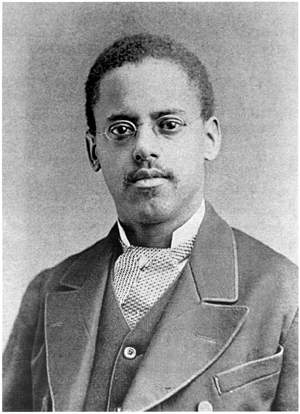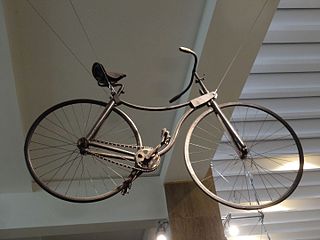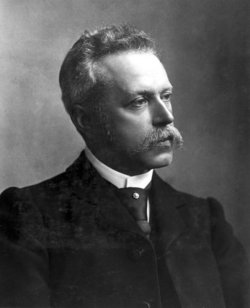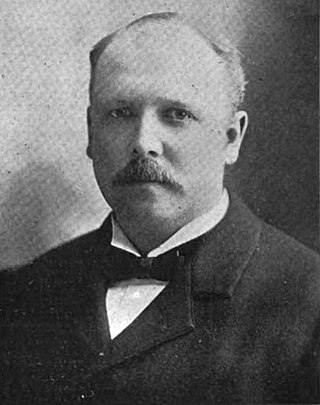
John McCammon, of Belfast, [1] developed an early safety bicycle in 1884. It had a step-through frame. [2] [3] [4]

John McCammon, of Belfast, [1] developed an early safety bicycle in 1884. It had a step-through frame. [2] [3] [4]

The 1880s was a decade of the Gregorian calendar that began on January 1, 1880, and ended on December 31, 1889.

The penny-farthing, also known as a high wheel, high wheeler or ordinary, is an early type of bicycle. It was popular in the 1870s and 1880s, with its large front wheel providing high speeds, owing to it travelling a large distance for every rotation of the legs, and comfort, because the large wheel provided greater shock absorption.

A bicycle chain is a roller chain that transfers power from the pedals to the drive-wheel of a bicycle, thus propelling it. Most bicycle chains are made from plain carbon or alloy steel, but some are nickel-plated to prevent rust, or simply for aesthetics.
The year 1885 in science and technology involved some significant events, listed below.

Lewis Howard Latimer was an American inventor and patent draftsman. His inventions included an evaporative air conditioner, an improved process for manufacturing carbon filaments for light bulbs, and an improved toilet system for railroad cars. In 1884, he joined the Edison Electric Light Company where he worked as a draftsman.

John Boyd Dunlop was a Scottish inventor and veterinary surgeon who spent most of his career in Ireland. Familiar with making rubber devices, he invented the first practical pneumatic tyres for his child's tricycle and developed them for use in cycle racing. He sold his rights to the pneumatic tyres to a company he formed with the president of the Irish Cyclists' Association, Harvey du Cros, for a small cash sum and a small shareholding in their pneumatic tyre business. Dunlop withdrew in 1896. The company that bore his name, Dunlop Pneumatic Tyre Company, was not incorporated until later using the name well known to the public, but it was Du Cros's creation.

Vehicles that have two wheels and require balancing by the rider date back to the early 19th century. The first means of transport making use of two wheels arranged consecutively, and thus the archetype of the bicycle, was the German draisine dating back to 1817. The term bicycle was coined in France in the 1860s, and the descriptive title "penny farthing", used to describe an "ordinary bicycle", is a 19th-century term.

A safety bicycle is a type of bicycle that became very popular beginning in the late 1880s as an alternative to the penny-farthing and is now the most common type of bicycle. Early bicycles of this style were known as safety bicycles because they were noted for, and marketed as, being safer than the high wheelers they were replacing. Even though modern bicycles use a similar design, the term is rarely used today and is considered obsolete outside circles familiar with high wheelers.

Henry George Ferguson was an Irish mechanic and inventor who is noted for his role in the development of the modern agricultural tractor and its three point linkage system, for being the first person in Ireland to build and fly his own aeroplane, and for developing the first four-wheel drive Formula One car, the Ferguson P99.

John Kemp Starley was an English inventor and industrialist who is widely considered the inventor of the modern bicycle, and also originator of the tradename Rover.

The rim is the "outer edge of a wheel, holding the tire". It makes up the outer circular design of the wheel on which the inside edge of the tire is mounted on vehicles such as automobiles. For example, on a bicycle wheel the rim is a large hoop attached to the outer ends of the spokes of the wheel that holds the tire and tube. In cross-section, the rim is deep in the center and shallow at the outer edges, thus forming a "U" shape that supports the bead of the tire casing.
Pope Manufacturing Company was founded by Albert Augustus Pope around 1876 in Boston, Massachusetts, US and incorporated in Hartford, Connecticut in 1877. Manufacturing of bicycles began in 1878 in Hartford at the Weed Sewing Machine Company factory. Pope manufactured bicycles, motorcycles, and automobiles. From 1905 to 1913, Pope gradually consolidated manufacturing to the Westfield Mass plant. The main offices remained in Hartford. It ceased automobile production in 1915 and ceased motorcycle production in 1918. The company subsequently underwent a variety of changes in form, name and product lines through the intervening years. To this day, bicycles continue to be sold under the Columbia brand.

Wire wheels, wire-spoked wheels, tension-spoked wheels, or "suspension" wheels are wheels whose rims connect to their hubs by wire spokes. Although these wires are considerably stiffer than a similar diameter wire rope, they function mechanically the same as tensioned flexible wires, keeping the rim true while supporting applied loads. The term suspension wheel should not be confused with vehicle suspension.

Henry John Lawson, also known as Harry Lawson, was a British bicycle designer, racing cyclist, motor industry pioneer, and fraudster. As part of his attempt to create and control a British motor industry Lawson formed and co floated The Daimler Motor Company Limited in London in 1896. It later began manufacture in Coventry. Lawson organised the 1896 Emancipation Day drive now commemorated annually by the London to Brighton Veteran Car Run on the same course.
Events from the year 1888 in the United Kingdom. This year is noted for the first Whitechapel murders.
William Hume was an Irish cyclist. He demonstrated the supremacy of John Boyd Dunlop's newly invented pneumatic tyres in 1889, winning the tyre's first ever races in Ireland and then England.

The American Star Bicycle was invented in 1880 by G. W. Pressey and manufactured by the H. B. Smith Machine Company in Smithville, Burlington County, New Jersey. It was characterized by a small wheel in front to avoid the problem of tipping forward inherent in other high wheelers. A Star bicycle was photographed being ridden down the steps in front of the United States Capitol in 1885 to demonstrate its longitudinal stability, and Star bicycles were used for the sport of bicycle polo in the mid-1880s. Pressey sued Smith in 1887 for royalties. The name "Star" was attributed to the double star arrangement of the spokes.
Klein was a bicycle company founded by Gary Klein that pioneered the use of large diameter aluminium alloy tubes for greater stiffness and lower weight.

Whippet was a brand of safety bicycle designed by C. M. Linley and manufactured by Linley and Briggs in London. Examples exist from 1885 and 1888. They are notable for their use of springs to suspend the frame. An early external derailleur, that enabled two gear ratios and used a freewheel hub was introduced in the summer of 1894, and was available only on Whippet bicycles.

George R. Bidwell was a pioneering bicycle salesman and manufacturer. Active in politics as a Republican, from July 14, 1897, to April 3, 1902, he was Collector of the Port of New York.
John McCammon of Belfast applied for a patent for his invention of a bicycle.
J. McCammon patented a dwarf bicycle suitable for ladies.
A McCammon safety of 1884